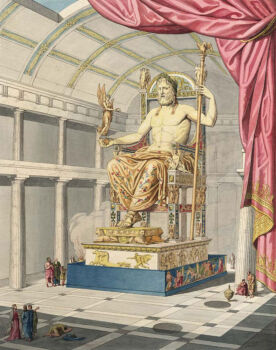The astonishing works of art known as “The Seven Wonders of the World” continue to inspire and are celebrated as the most remarkable products of creativity during Earth’s early civilizations. At the same time, they are a reminder of the human capacity for disagreement and destruction.

Image source: https://en.wikipedia.org/wiki/Seven_Wonders_of_the_Ancient_World#/media/File:SevenWondersOfTheWorld.png
Lost Wonders
The Seven Wonders of the Ancient World was a list of extraordinary construction reported by different classical authors, such as Philo of Byzantium, Herodotus, Callimachus of Cyrene. Defined as themata (which we can translate with “must see”), the Seven Wonders were popular among Hellenic tourists and reported in ancient guidebooks. These buildings fascinated humanists through the years, and other listings were redacted. Today only the Great Pyramid of Giza, is still visible and relatively intact.
Great Pyramid of Giza
The largest of the three pyramids of Giza, the Great Pyramid is the oldest of the Seven Wonders, dated back to the mid of the third millennium BC. The 2.3 million blocks pyramid was built for the Pharaoh Khufu (better known as Cheops), and it was the tallest manmade building for almost 3,800 years. The excavations of the pyramid started at the end of the 18th century, so the interior chambers were unknown to ancient visitors. The surface of the façades, today undecorated, were originally covered with impressive white fine limestone blocks, destroyed in a massive earthquake. Some scholars assume that this building, similarly to other pyramids, was topped by a golden or electrum capstone, which is missing today.

Image source: https://en.wikipedia.org/wiki/Great_Pyramid_of_Giza#/media/File:Kheops-Pyramid.jpg
Hanging Gardens of Babylon
Archaeologists never found evidence of the existence of this wonder. However, the Hanging Gardens of Babylon were described by Diodorus Siculus during one of his voyages. Probably they were built by Nebuchadnezzar II in the 6th century BC and gifted to his wife. This masterpiece of engineering consisted of 23 meters-high climbing terraces of exotic flora and fauna. Every terrace was self-watered. While Diodorus explains that Amtis, the wife of Nebuchadnezzar II, missed her native country, and so the king commanded to build the Hanging Gardens in Babylon, this remarkable wonder is not even mentioned in Babylonian history or Herodotus’ claims. They were supposedly destroyed after the 1st century AD by an earthquake.

Image source: https://en.wikipedia.org/wiki/Hanging_Gardens_of_Babylon#/media/File:Hanging_Gardens_of_Babylon.jpg
Statue of Zeus at Olympia
This magnificent statue of Zeus was commissioned by the Eleans to the Greek sculptor Phidias around the 5th century BC. The famous sculptor Phidias worked also on other important buildings, such as the Parthenon. The statue was sculpted for the Temple of Zeus in Olympia and depicted the god of Olympus seated on his throne; the skin was made from ivory, and the god wore gilded robes made from glass. He was crowned with an olive wreath. The right hand held Nike, goddess of victory, while the left one a scepter. When the Olympic Games were banished by the rising Christianity, the Temple at Olympia fell into ruin. The statue was removed and carried to Constantinople where it was later destroyed by an earthquake.

Image source: https://en.wikipedia.org/wiki/Statue_of_Zeus_at_Olympia#/media/File:Le_Jupiter_Olympien_ou_l’art_de_la_sculpture_antique.jpg
Temple of Artemis at Ephesus
The Temple of Artemis at Ephesus was completed in the 5th century BC. This majestic structure was considered the most impressive structure ever raised by human beings. The lot of this temple, which took over 120 years to build, was not happy. It was commissioned by the King Croesus of Lydia and is located near the ancient city of Ephesus. It is probably the earliest Greek temple surrounded by colonnades anywhere. Anyway, this magnificent building was destroyed in a fire set by a man named Herostratus, the night Alexander the Great was born. Later it was rebuilt after Alexander’s death on a smaller scale and destroyed again by the invasion of the Goths. Rebuilt, it was destroyed for the last time by the Christians, headed by Saint John Chrysostom.

Image source:https://en.wikipedia.org/wiki/Temple_of_Artemis#/media/File:Miniaturk_009.jpg

Image source: https://en.wikipedia.org/wiki/Temple_of_Artemis#/media/File:Temple_of_Artemis.jpg
Mausoleum at Halicarnassus
Artemisia II built this mausoleum as a tomb for her brother-husband Mausolus, during the 4th century BC. Halicarnassus was the capital city of Mausolus’ empire and the tomb should have been up to such magnificence. The structure was erected on a hill overlooking the capital and featured an enclosed courtyard in the center of which laid the king’s tomb. On the top thirty-six slim columns held the pyramidal roof, topped by a statue of a quadriga. This beautiful building determined the name “mausoleum”, from the king who was resting inside. It was destroyed by a series of earthquakes completely dismantled after two millenniums.

Colossus of Rhodes
The Colossus of Rhodes was a statue representing the god Helios, patron of the city, built during the 3rd century BC. The statue was 33 meters high and overlooked the harbor of Rhodes. The statue was commissioned after the defeat of the invading army of Demetrius, and the sale of the equipment left by the fleeing army. According to Strabo, despite the colossus was destroyed in a violent earthquake, the statue was so impressive that the ruins were still a tourist attraction. Theophanes reports that the bronze ruins were a Jewish merchant and melted down during the 7th century AD.

Image source: https://en.wikipedia.org/wiki/Colossus_of_Rhodes#/media/File:Colosse_de_Rhodes_(Barclay).jpg
Lighthouse of Alexandria
Ptolemy I Sother commissioned this amazing lighthouse during his reign. The construction was built on the island of Pharos and completed in the early 3rd century BC. With a height of 134 meters was one of the tallest structures of the world, after the pyramids and its light could be seen from different miles out to sea. The lighthouse was made of three different parts: the first part was a square base, followed by a middle octagonal section up to a circular top. Seriously damaged in an earthquake during the Middle Age, this wonder was gone before the end of the Renaissance Period.

Image source: https://en.wikipedia.org/wiki/Lighthouse_of_Alexandria#/media/File:Lighthouse_-_Thiersch.png

Image source: https://commons.wikimedia.org/wiki/File:Leuchtturm_von_Alexandria.png Author:SciVi 3D studio
Info source: https://www.ancient.eu/The_Seven_Wonders/ https://en.wikipedia.org/wiki/Seven_Wonders_of_the_Ancient_World https://curiosmos.com/the-mystery-behind-the-missing-capstone-of-the-great-pyramid-of-giza/
